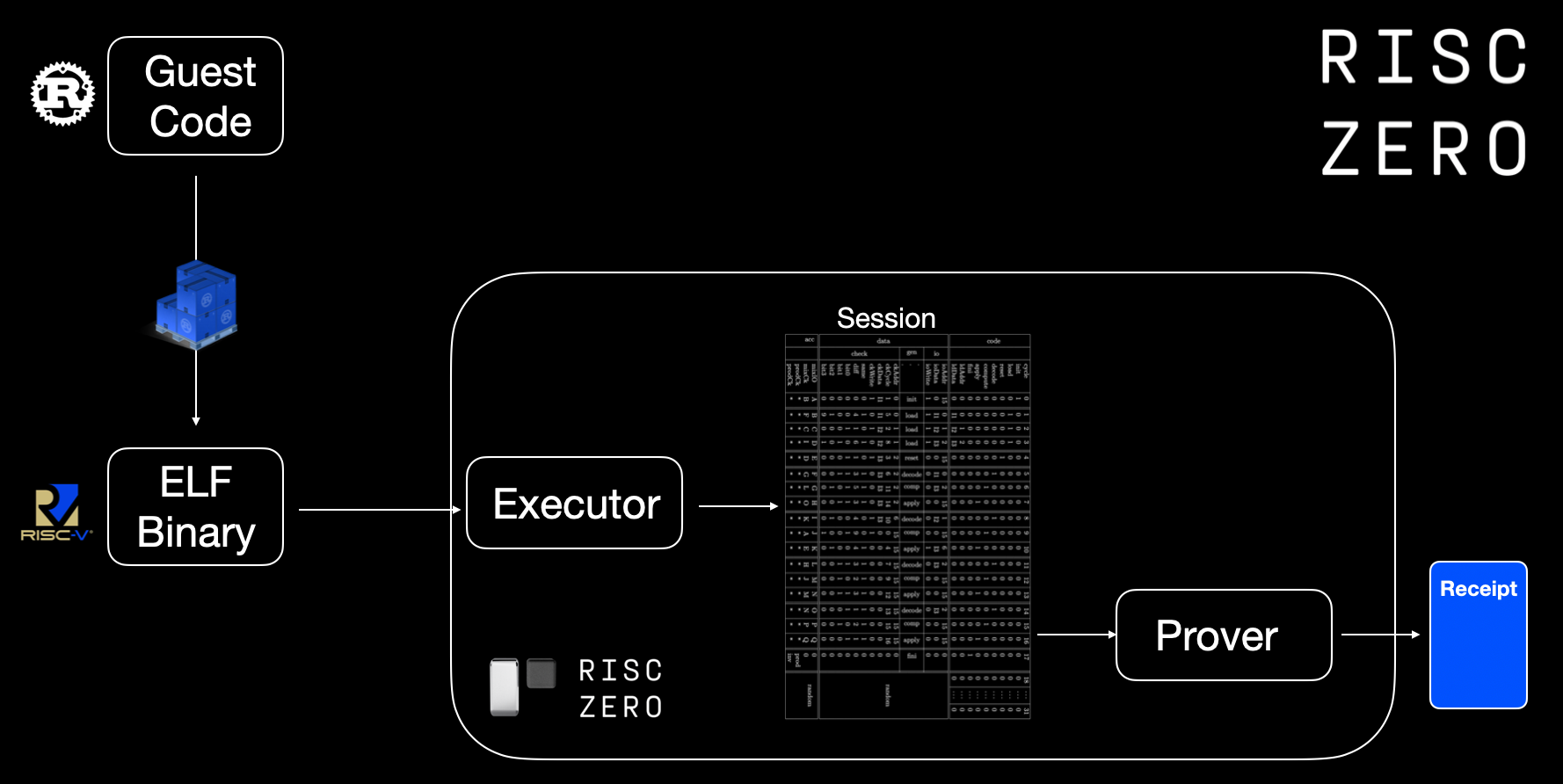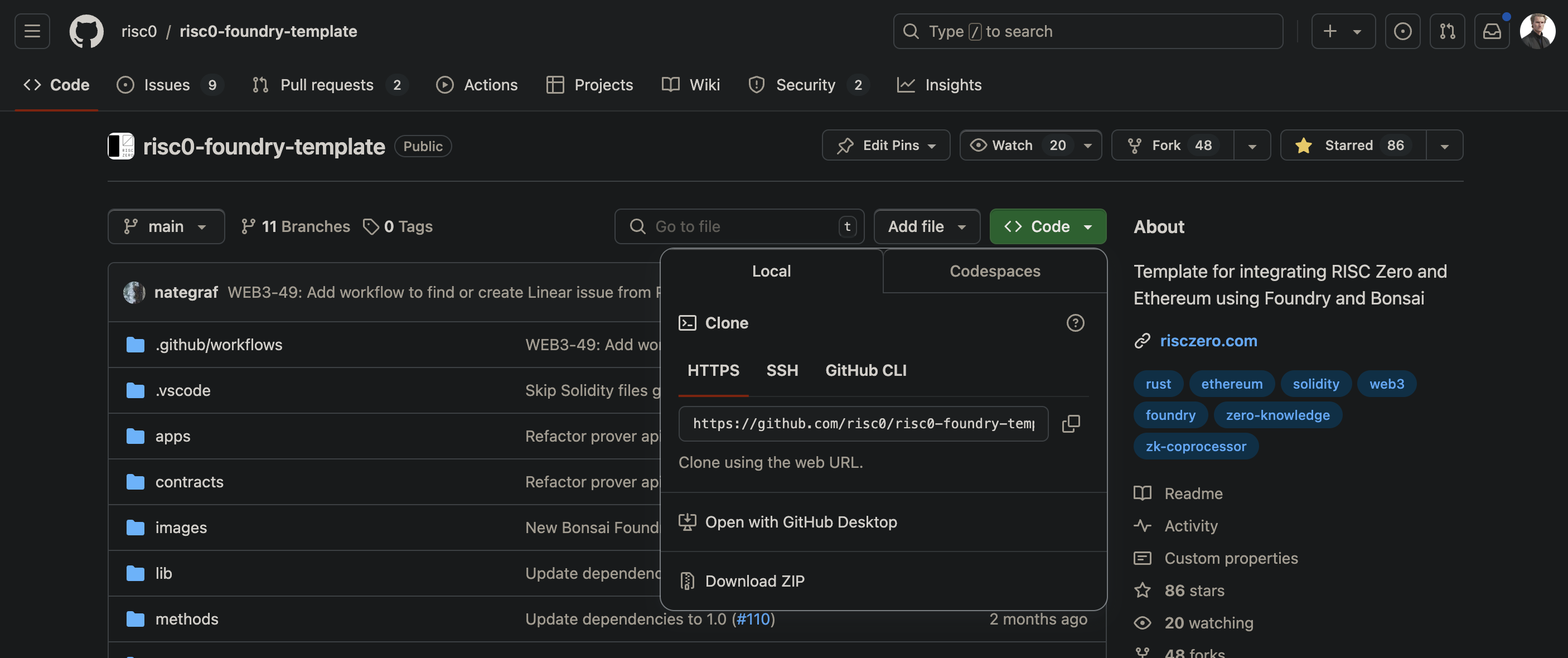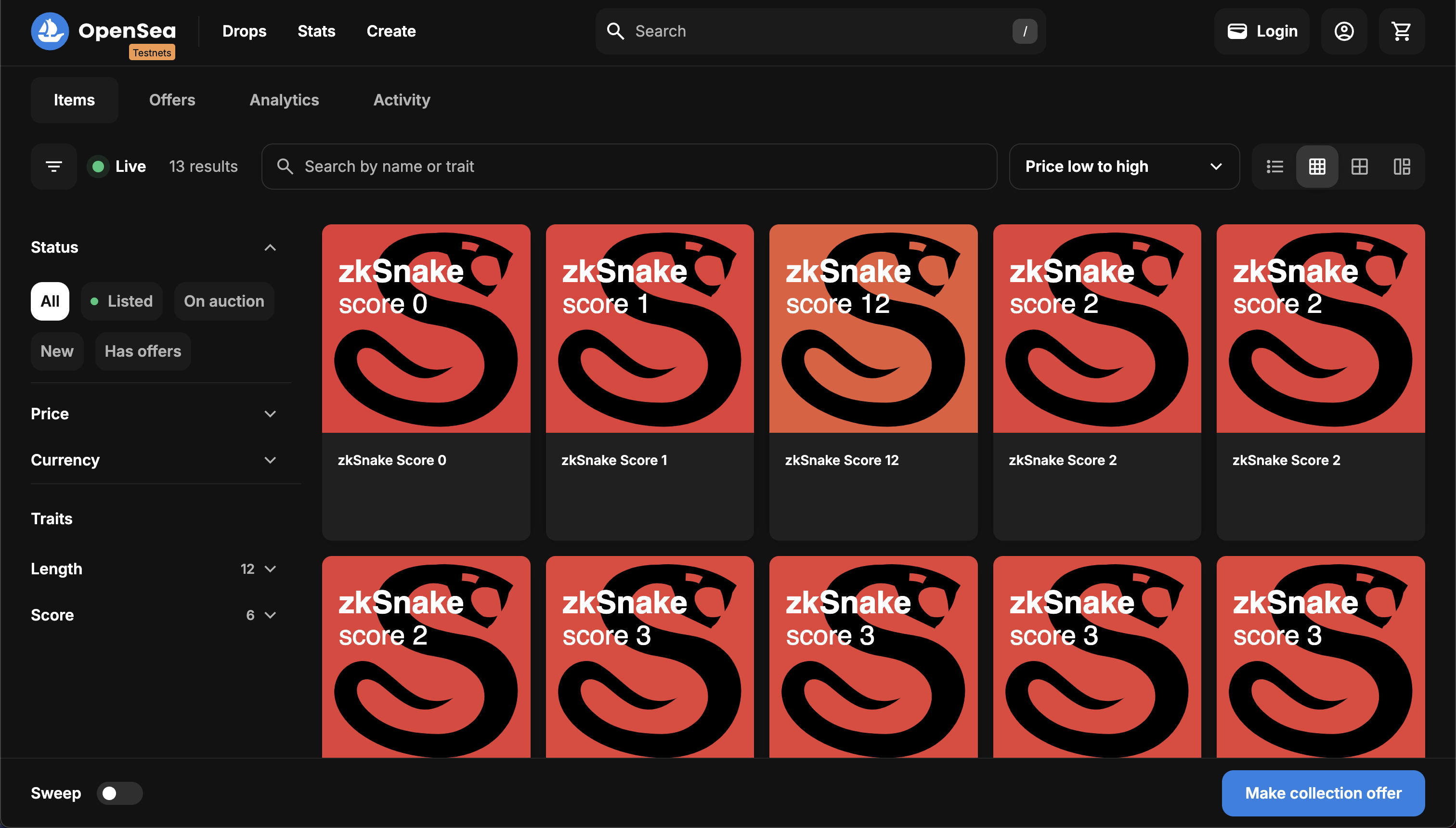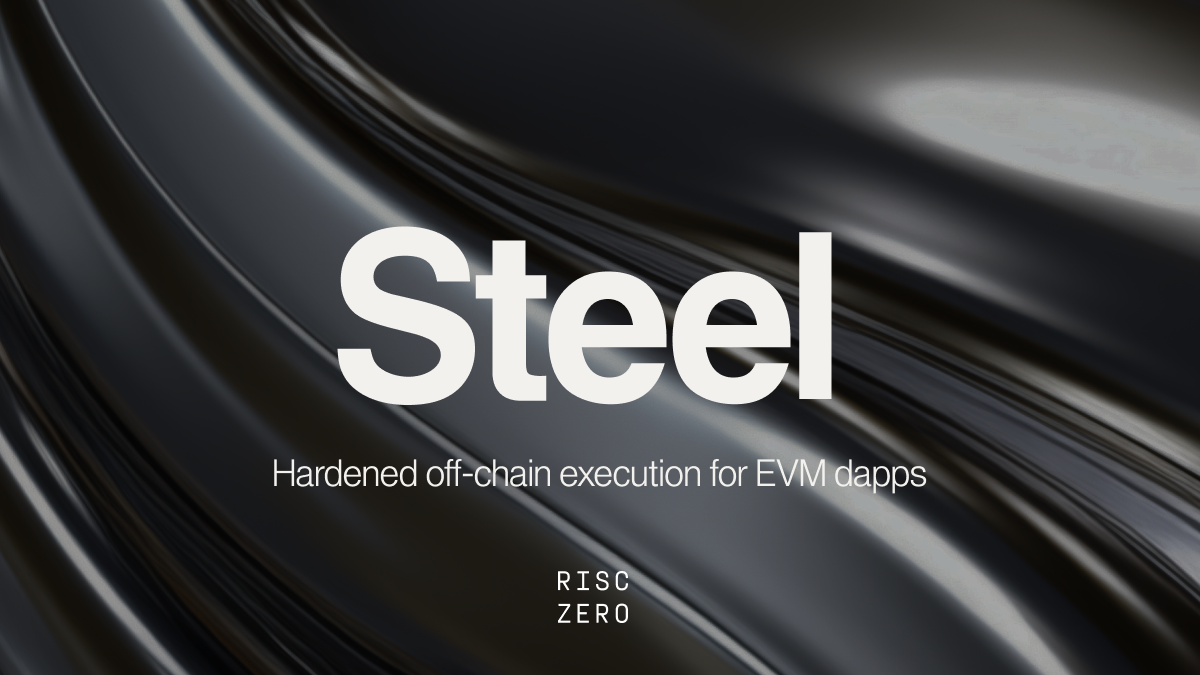Boundless On-chain Execution Using Proven Off-chain Coprocessing
How to use the slides - Full screen (new tab)
Boundless On-chain Execution
Using Proven Off-chain Coprocessing

On-chain $~~~$ 👉 $ZK$ 👈 $~~~$ Off-chain
Why RISC Zero?
Write Rust 🦀
Not Circuits 𝛌
Notes:
Story time!
Started in self-sovereign tech rabbit whole 2018 ETHDenver. Mesh networks, local first, DAOs and co-ops, token engineering... Then I found out about ZKPs and what they can do to fundamentally change the game and enable things that were impossible before. As an fanboi of the ZK Podcast for years, I wanted so much to get in... but there was a problem: learning curve on cryptography. I want to build cryptographic systems, but not need to deeply understand the moon math... Enter zkVMs: RISC Zero. Now we can all make ZKPs with only a strong conceptual grasp of constraint systems and Rust (more languages to come!)
Why RISC Zero?
- Verifiable Computation: outsource-able
- Highly Scalable: low-cost verification
- Tunable Privacy: robust & universal*
Notes:
- you can verify that a computation of a specific program ran exactly as it should, even if done by untrusted executor!
- Prover that runs program & produces receipt reveals as little as nothing to everything about execution to verifier.
- Verification is significantly cheaper than running computation yourself... at the cost of prover doing significantly more work to run the zkVM
- * Privacy is from everyone outside the prover, if you are the prover, no one but you has secret data.
Why RISC Zero?
It's a hackathon... 💰
RISC Zero Bounties 🤑
- 🤩 Best zkVM Application - 2x 500 USD
- 🤝 ZK Coprocessor - 4x 500 USD
- 👪 Integrations - 15x 200 USD
Qualifications on Devfolio 👀
What key web3 problems can ZK address?
EVM Devs
- Referring to historical state
- Trusting off-chain logic
- Boundless Execution
Layer <0|1|2|...> Devs
- Selective Privacy*
- Scalability (Compression)
- Interoperability (🌉, rollups)
Notes:
- RETH / REVM -> ZETH - support EVM execution of contracts, REVM for only parts.
- Also supports verifiable merkle proof of subset of global evm state.
- ZK coprocessor - run verifiable program logic in zkVM by 3rd party or yourself to untrusting parties
- Added security and fairness and privacy that zero knowledge proofs can provide, as they involve complex decision-making and competitive interactions.
- Privacy is optional, fully transparent games with ZKPs can provided added guarantees around many things other than that (if carefully designed)
- * Privacy is not "true" Zero Knowledge - math details in this paper: https://eprint.iacr.org/2024/1037.pdf
- Privacy can be selective: reveal to particular parties explicitly.
RISC Zero 101

Read Getting Started and/or watch the playlist.
Notes:
- deeper understanding as exercise for views of this presentation.
- very happy to answer questions on our discord!
RISC Zero 🤝 EVM Chains

Read about Blockchain Integration and watch the Foundry Template playlist.

Notes:
So you’ve heard about why you might want to use ZK and therefore, why you should use RISC Zero’s zkVM. Nuke’s done an excellent job there. For my part of the presentation, let’s all put our blockchain developer hat on. For the longest time, this hat meant using Hardhat.

Notes:
The developer framework that's all the rage these days, and one that we are very fond of at RISC Zero is Foundry. Unfortunately, doesn't fit into my blockchain developer hat metaphor as we've switched to only metal metaphors because of Rust.

Notes:
And its because of Rust, that Foundry integrates very well into the RISC Zero zkVM stack. We love it so much that we want to make developer's life easier and so we've created the Risc Zero Foundry template.

Notes:
You simply clone this repo and run a few commands to get started. Let's walkthrough that quickly and then we can get to the meat of understanding what's going on.
git clone https://github.com/risc0/risc0-foundry-template.git
function set(uint256 x, bytes calldata seal) public {
bytes memory journal = abi.encode(x);
verifier.verify(seal, imageId, sha256(journal));
number = x;
}
Notes:
Let’s jump straight to contracts/EvenNumber.sol and straight to the function and its arguments that requires a proof to be verified.
Interestingly, we don't know what the verification is here, especially with a strange function name called 'set' and no comments (though I removed those for the presentation). Why is that? Well, we've offloaded computation here from the EVM to Risc Zero's zkVM.
Let's have a look at a function that does the exact same thing directly in Solidity.
function set(uint256 x) public {
require(x % 2 == 0, "Not an even number");
number = x;
}
Notes:
What are we doing here? This function is way easier to understand as its all done directly in Solidity.
All we're doing here is checking if an input number is even, and if so, update the current variable number to that new proven even number.
So what was all the journal and seal about? Let's go back to it
function set(uint256 x, bytes calldata seal) public {
bytes memory journal = abi.encode(x);
verifier.verify(seal, imageId, sha256(journal));
number = x;
}
Notes:
At first glance, we look like we’ve actually complicated things, after all the function with the require statement doesn’t require strange arguments like a seal, or to create a journal.
Sounds like we are working in a medieval library.
Thankfully, we live in the 21st century post the discovery of zero knowledge cryptography, so just like our medieval ancestors lamented about their lack of ability to take compute off-chain, we can lament that we have silly variable names like journal and seal.
I know which choice I would take any day.
Back to the matter at hand, these two functions carry out the same computation (checking a number is even) but that computation is not carried out in the same place, or on the same ‘virtual machine’.
One is the EVM, and the other is RISC Zero’s zkVM.
We can see that the function that utilizes the zkVM for checking a number is even, requires an extra input argument called the seal.
RISC Zero 101

Recall: the RECEIPT contains the Seal & Journal (Committed Outputs)
Notes:
- deeper understanding as exercise for views of this presentation.
- very happy to answer questions on our discord!
Seal
- The seal is a zk-STARK or zk-SNARK.
- It cryptographically attests to the correct execution of the
guest program. - The
guest programis checking the parity ofx--> proof.
Notes:
The seal is either a STARK or a SNARK generated by the prover (a party off-chain, we’ll delve into the specifics of Bonsai as a coprocessor later).
The seal cryptographically attests to correct execution of the guest program as well as the outputs of that guest program.
The guest program is a Rust program which takes an input number, x and checks if x is divisible by 2, if so the computation executes successfully and a proof is generated.
So we have the seal, in this case as we’re dealing with an onchain environment, it’s a SNARK.
SNARKs are smaller proofs compared to STARKs, making them more gas-efficient for onchain verification.
Journal
- Contains the public outputs of the computation
function set(uint256 x, bytes calldata seal) public {
bytes memory journal = abi.encode(x);
verifier.verify(seal, imageId, sha256(journal));
number = x;
}
Notes:
The journal contains the public outputs of the computation. We’ll see later on that we used Solidity’s ABI encoding when ‘committing` x to the journal. This is done to make decoding information easier on the Solidity side of things once we’re in the app contract as we are here.
We are taking a number x in the input of the solidity function, we’d like to make sure that this number x is the one that was checked to be even in the guest program. For this reason, we actually reconstruct the journal onchain here, and pass that through to the verify function. If the journal does not match the proof, verify will fail. So that’s a handy way of making sure that everything is going smoothly.
A quick note, this reconstruction of the journal is not always feasible. This example is straightforward, and handles only one number variable. Most real world applications, including those that you’ll build yourself, will have a higher degree of complexity. In those cases, recreating the journal onchain might seem counterintuitive in a world where we are trying to save gas. In most cases, passing the journal through as an argument and decoding that onchain to have some sanity checks would be the better way of doing it. This will become a lot clearer later, when Nuke comes back on to walk you through the guest program specifically.
Verification
function set(uint256 x, bytes calldata seal) public {
bytes memory journal = abi.encode(x);
verifier.verify(seal, imageId, sha256(journal));
number = x;
}
Notes:
Verification is handled by RISC Zero’s verification contract, which you can find deployed across many different chains. In our application contract, the verification contract address is instantiated at deploy time as a constructor argument. The verification contract is actually a proxy contract, and so you can be sure if any new features are added to the verification contract, this address will stay valid in your application.
verify takes the seal or the proof, the imageId and a hash of the journal. The proof is verified and the imageId and journal variables here attest that the correct ELF binary was run in the zkVM with the corresponding identifier imageId, and the correct outputs were calculated within the zkVM via the journal. Note that if anything is wrong, the verify function will revert and the error will be bubbled up through require statements, which you can see with the likes of Tenderly simulations when debugging on testnets before deploying to production on mainnet.
Going back to the function as a whole, and you can now see that, given the guest program does indeed check if a number is even, that the two functions that were shown previously are in fact identical in their conclusion: only update the state of number if it’s even.
Why?
- Doesn't this seem a little overkill?
Notes:
This may all seem overkill for checking if a number is even, and you can be forgiven for thinking that, but actually if you benchmark testing 1 number, 10 numbers, 100 numbers and so on, I’d be interested to see hands up for how many numbers it takes before it becomes pretty much unfeasible to do this simple computation (albeit repeatedly) onchain.
Thankfully, we don’t have to guess and I wrote a simple contract that modified what we saw here today. Hopefully, this gets across why (and how badly) ZK is needed for scaling compute onchain.
Gas Benchmarks
- [PASS] testGas1Number() (gas: 71015)
- [PASS] testGas10Numbers() (gas: 259748) --> $10
- [PASS] testGas1000Numbers() (gas: 23083559) --> $900
- [PASS] testGas10000Numbers() (gas: 231464264)
Notes:
In this example, we are checking an array of numbers onchain, and saving them to a results array if they’re even. So to check 10 numbers, it costs 260k gas here.
On L1, at an ETH price of $2500$, with a gas price of around 15 gwei, 260k gas costs around $10. Each number is costing you one dollar. Checking 1000 numbers at 23M gas, is probably impossible unless you’re some sort of whale with your own large amount of validators to help inclusion, but thats just under 900 dollars.
Think to your personal laptop from 10 years ago, that thing could do this calculation is probably nanoseconds. Food for thought.
App

Notes:
Back to zkVM reality.
We’ve walked through the Ethereum side of this image, and to some extent, you can understand what our proving API, Bonsai handles from the explanation and the code we’ve walked through already.
The middle part of the diagram, which is labelled app, is a crucial part of any application utilizing RISC Zero’s zkVM.
In the foundry template, you can find its source code in apps/src/bin under publisher.rs.
As the name suggests, the main end purpose of this code is to publish a proof to your application contract where it’s needed for verification for some state update, i.e. EvenNumber.sol's set function.
In practice, this means sending a transaction onchain with the required arguments.
But in fact, publishing is just one part of the publisher, and the diagram also shows that it handles the request for a proof from Bonsai first and acts as middleware to receive that proof and package it up nicely to send to your app contract.
Let’s walk through the main aspects of the publisher app in the Foundry Template.
App CLI
cargo run --bin publisher -- \
--chain-id=11155111 \
--rpc-url=https://eth-sepolia.g.alchemy.com/v2/${ALCHEMY_API_KEY:?} \
--contract=${EVEN_NUMBER_ADDRESS:?} \
--input=12345678
Notes:
We have 4 arguments, chainId, rpc-url, contract address and input.
These arguments are all related to your application contract.
This will tell the publisher app what chain you are using, what RPC url to use to talk to that chain, the contract address of your application and the input argument i.e. prove the parity of this input number.
Proving Options
#![allow(unused)] fn main() { let receipt = default_prover() .prove_with_ctx( env, &VerifierContext::default(), IS_EVEN_ELF, &ProverOpts::groth16(), )? .receipt; }
Notes:
That’s fine, interfacing with the chain in ethers.rs or now alloy, also relatively straightforward.
So all we have left is interfacing with Bonsai, and RISC Zero makes that directly available from the default_prover() object.
The doc comments are very helpful here and the RISC Zero team do a great job on that, if you hover over default_prover(), you get a full LSP explanation (next slide).
Proving Options 🤌
-
BonsaiProverif theBONSAI_API_URLandBONSAI_API_KEYenvironment variables are set unlessRISC0_DEV_MODEis enabled. -
LocalProverif theprovefeature flag is enabled.
Notes:
If environment variables BONSAI_API_URL and BONSAI_API_KEY are set, Bonsai will be used automatically for proving, directly from the proving method.
Get the seal/journal from the receipt
#![allow(unused)] fn main() { // Encode the seal with the selector. let seal = groth16::encode(receipt.inner.groth16()?.seal.clone())?; // Extract the journal from the receipt. let journal = receipt.journal.bytes.clone(); }
Notes:
Back to publisher.rs, and our trusty seal and journal which we can extract from the receipt that proving on Bonsai returns.
Decoding the journal
#![allow(unused)] fn main() { let x = U256::abi_decode(&journal, true).context("decoding journal data")?; }
Notes:
Upon receiving the proof, the app decodes the journal to extract the verified number. This ensures that the number being submitted to the blockchain matches the number that was verified off-chain.
Constructing the calldata
#![allow(unused)] fn main() { let calldata = IEvenNumber::IEvenNumberCalls::set(IEvenNumber::setCall { x, seal: seal.into(), }) .abi_encode(); }
Notes:
Using the IEvenNumber interface, the application ABI-encodes the function call for the 'set' function of the EvenNumber contract. This call includes the verified number, and the seal (proof).
Summary
- We've used RISC Zero's zkVM for an onchain app.
- We've carried out computation off-chain and seen it saves a lot of gas.
- Gas is expensive.
Notes:
To sum up, we’ve used RISC Zero’s zkVM for an onchain app, specifically to verify computation off-chain and save a lot of gas. We installed RISC Zero’s toolchain using rzup, installed Foundry Template, we’ve seen that gas is really expensive and we’ve walked through the Solidity side of things with EvenNumber.sol representing the onchain part of where you want to save gas and how to verify proofs generated by the zkVM onchain.
Publisher - super important ‼️

Notes:
Finally, we’ve seen the importance of the publisher as the main orchestrator requesting the proof from Bonsai, interacting with the application contract (a lot of the relevant parameters are specified via input arguments to the publisher CLI), and actually being the ‘backend’ of offloading the computation from the EVM over to the zkVM.
Now I’ll hand back over to Nuke to discuss the specifics of the zkVM in more detail. Thanks.
✨ Inspiration
⚠️ Do not copy 🍝 ⚠️
Notes:
Plagiarism, missing attribution and violating licenses will disqualify you! Building on them to something significantly enhancements may be considered - please let us know what you are planning :grin:
zkSnake (R0 v0.20)
Prove your score in a Snake Game using Zero-Knowledge
Proof-of-Concept for provable gaming
zkSnake Source ↗️
Notes:
- Prevent cheating (if somebody modifies game code to increase luck)
- Trustless score verification to issue rewards
- Delegate expensive computation to the client side
zkSnake Demo
Notes:
- Go over gameplay
- After click on mint button
- transaction with game data gets sent onchain
- data gets picked up by risc0
- risc0 Bonsai generates a proof
- proof gets published and nft gets minted
zkSnake Demo

Notes:
- Developing on RISC Zero was incredibly easy, and didn't require any ZK knowledge
- Winner of RISC Zero Coprocessor Bounty at ETHDenver 2024 and did well in community quadratic voting too!
- Idea: take it further and make a bevy app in wasm w/ webGPU with shared core logic identical on web & "re-player" zkVM
Proven Historical State of EVM

A trustless "off-chain worker" for EVM RPC calls, and more!
Notes:
Want to build even more complicated or otherwise impossible contract logic? Enter Steel - view call library. Example: view call that checks existence of balance on chain, like in our ERC20 example workshop!
👷 Signing and Steeling Workshop
Join in following the Hands-on instructions ↗️
🎇 What is special about RISC Zero? (1)
- Developer productivity (@ hackathons & beyond)
Top 1000 crates.io tested nightly,
benchmarks and more: reports.risczero.com - Hard in zkDSL, easy in zkVM:
Loops & branching
Design 🡺 Implementation 🡺 Auditing
Notes:
- Lots of ZKP options, why use R0?
- zkDSL could be more performant, but time to market is very high, small set of humans can implement them at all.
- Why use us over other zkVMs? First, arguably best devex, v1.0 release stability and prover performance milestones!
🎇 What is special about RISC Zero? (2)
- Proof continuation
Boundless guest programs - Proof composition
"Proof-ception"
Hybrid Client side {🕵️privacy} & server {🦾power} - Execution separate from proof generation
Notes:
- Proof-ception = efficient verification of proofs within a guest.
- Privacy for small client side proofs and the bulk of proof computational overhead outsourced to an untrusted prover.
- Reuse of existing proofs included in new proof using their journal
- Batching/compression of many proofs
- Proof transposition for compatibility of specific verifiers.
- Execution is near zero overhead, proving is high overhead.
- Realtime exec & prove in parallel / after / remote is possible
- What killer features does R0 provide?
🎇 What is special about RISC Zero? (3)
⛓️ EVM Support ⛓️
- RISC Zero Foundry template
Write unbounded programs for EVM chains - Ethereum contracts, proof systems, and more
View call proofs with Steel
ZK Rollups & RollApps
...Help us define more!
Notes:
- Zeth could run existing solidity games off chain, optionally unbounded computation per block (gasless). Zeth deep dive
- mention: 256 view call limit - could you do inclusion proof checkpoints? contract state is simply recursive proof of minimal thing needed (maybe block header / hash?) updated by anyone to use for deep archival view calls? prove "this state was in block X that is a child of recent block {younger than 256}"
🤿 Before you dive deep...
- You must match versions of
cargo risczeroand your Cargo.toml deps
Some examples / templates may not be the version you need!
Use^1.0versions throughout. - Keep guest minimal - extra cycles are expensive
...But this is a hackathon, don't stress too much! - When experimenting, always use
DEV_MODE!
Execution only with mocked proving (fast!) - Bonsai API key priority & support
Apply: bonsai.xyz/ (manual review & approval from our team) - Discord
#💻|support-forumchannel for help
Join: discord.gg/risczero
🧠 Don't need to know the crypto details to build...
BUT don't forget you are building a cryptographic system!